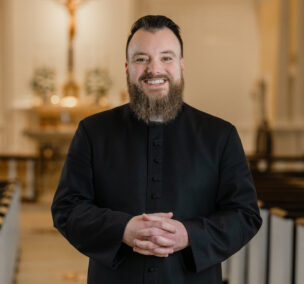Dear Brothers and Sisters in Christ,
The first letter of St. John stands as a Scriptural bridge between the Gospel of John and the other epistles of the Beloved Apostle. In this first letter, which is really more of a theological reflection (the other two letters of John have an introductory address and closing salutation that place them more squarely in the category of “letters”), John teaches his readers something of the nature of God (culminating in the famous and pithy verse “God is love”) and man’s relationship to the Divinity. This short book of the Bible can shed some light on today’s great solemnity of the Most Holy Trinity. Today, the Church asks us to contemplate a foundational mystery of our faith – namely that God is a Trinity of Divine Persons, Father, Son, and Holy Spirit. The Three Persons of the Trinity are distinct relationally, yet one in their Divine nature.
With the first letter of St. John as our guide we can see the mystery of the Trinity more clearly and understand how this mystery finds a place in our lives. In his famous work De Trinitate, St. Augustine presents a theology of the Trinity that focuses especially on the relations between the three Divine Persons. To understand God, we must understand relationship. When St. John writes “God is love” (1 John 4:16), we are meant to think of relationship immediately. The word love implies relationship: I say that I love this person, and the fact of that love indicates a relationship to and with that person. I say that I love this food, and the fact of that love indicates a relationship to that food. Of course, only a personal relationship can be mutual and reciprocal. I might love hamburgers, but they will never love me back. So when St. John tells us that God, who is one, is also love, we must understand that relationship is present in the Godhead. Not only is relationship present, but relationship is precisely what God invites. Many great theologians have observed that the Trinity is not a problem to be solved, but a mystery to engage with, a relationship in which one enters.
In God, we see perfect love. The love of God poured out is the foundation for our very being. And so St. John’s first letter teaches us the consequences of this love. Because God has so loved us, we must love God and love one another; a command which ought to immediately echo Jesus’ teaching that the first and greatest commandment is to love God, and the second is like it, to love our neighbor as ourself. Our profession of faith in the Triune God is not only an assertion of fact – God has been revealed to us as Three Persons – it also speaks the truth of our nature, namely, that created in the image and likeness of God, we have been made for relationship with God, created to be in relationship with one another.
Among the many ways our human relationships mirror our relationship with God (and the relationship that is the Trinity), our participation in the life of the Church stands out. From the very beginning, the Christian community has come together, shared resources, supported one another spiritually and materially. To be a Christian is to be part of a community. To belong to a parish church community means to participate in a relationship: we pray for one another, we support one another in need, we approach God together. Sometimes our participation in this relationship is limited to Mass attendance. It’s a great start, but often can leave one feeling disconnected from community. Sometimes participation in this relationship means joining a group or exercising a ministry. Sometimes someone who belongs to a parish is longing for a more intentional and serious relationship. Here at St. Pius, to help foster more intentional relationships and help this community to grow in the image of the Trinity, we are launching a special effort to form small groups. These small groups will be made up of 8 to 10 people who will commit to meeting together, to praying for one another, and to deepening their knowledge of the faith so as to build up the parish community more and more. I want to encourage your participation in these small faith groups. Please contact Paola, our Director of Evangelization, for more information: ppena@st-pius.org
One last thought. The mystery of the Trinity truly exceeds our power to comprehend. But we ought never be satisfied that “it’s a mystery” and thus stop seeking to understand. That would be like a husband saying “I told my wife I loved her on our wedding day, so I’m good for the rest of my life.” Obviously it doesn’t work. No, as those great theologians have said, the Trinity is not a problem to be solved, but a mystery to be engaged. While St. Augustine’s De Trinitate mentioned above presents an incredibly complex and deep understanding of the relational nature of God, it was a work that took him 30 years to complete. In other words, a lifetime of study, prayer, and intellectual wrestling. Our relationship with God, and the relationships we form within the Church and with the Church that reflect it, requires a lifetime. On this Trinity Sunday, we are invited to dive into the mystery, to know the depth of God’s love so beautifully articulated by the first letter of St. John. May that love lead us further into community with one another and into a lasting, holy communion with God.
Peace,
Fr. Sam


